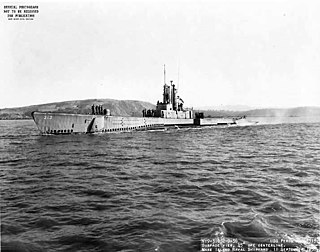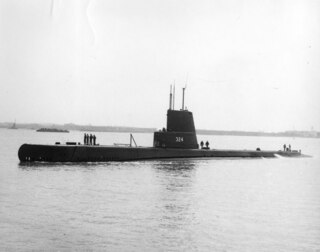
USS Blueback (SS-326), a Balao-class submarine in commission from 1944 to 1948, was the first submarine of the United States Navy to be named for the blueback salmon, also known as the sockeye salmon. She completed three war patrols in the South China Sea and Java Sea during World War II. She sank a 300-displacement ton submarine chaser as well as eight smaller vessels.

USS Flier (SS-250) was a Gato-class submarine, was the only ship of the United States Navy to be named for the flier.

USS Tuna (SS-203) was a United States Navy Tambor-class submarine, serving in the Pacific during World War II and earning seven battle stars for her service. After the war, she participated in the Bikini Atoll atomic testing in 1946.

USS Skipjack (SS-184), was a Salmon-class submarine, the second ship of the United States Navy to be named after the skipjack tuna. She earned multiple battle stars during World War II and then was sunk, remarkably, by an atomic bomb during post-World War II testing in Operation Crossroads. Among the most "thoroughly sunk" ships, she was refloated and then sunk a second time as a target ship two years later.

USS Bergall (SS-320), a Balao-class submarine in commission from 1944 to 1958, was the first ship of the United States Navy to be named for the bergall, a small fish of the New England coast. During World War II she made five war patrols between 8 September 1944 and 17 June 1945, operating in the South China Sea, Java Sea, and Lombok Strait and north of the Malay Barrier. During these patrols she sank two Japanese merchant ships totaling 14,710 gross register tons and one 740-displacement ton Imperial Japanese Navy frigate. She also damaged the Japanese heavy cruiser Myōkō, which was never repaired.

USS Scabbardfish (SS-397), a Balao-class submarine, was the only ship of the United States Navy to be named for the scabbarddfish, a long, compressed, silver-colored fish found on European coasts and around New Zealand. In 1965 she was transferred to the Hellenic Navy and renamed Triaina.

USS Mingo (SS-261) — a Gato-class submarine — was the first ship of the United States Navy to be named for the mingo snapper.

USS Muskallunge (SS-262), a Gato-class submarine, was a ship of the United States Navy named for the muskallunge.

USS Perch (SS/SSP/ASSP/APSS/LPSS/IXSS-313), a Balao-class submarine, was the second submarine of the United States Navy to be named for the perch, a freshwater spiny-finned fish.

USS Baya (SS/AGSS-318), a Balao-class submarine, was a ship of the United States Navy named for the baya. During World War II, she completed five war patrols in the South China Sea, Gulf of Siam, Java Sea, and Philippine Sea between 23 August 1944 and 25 July 1945. She sank four Japanese vessels totaling 8855 gross register tons, and shared credit with the submarine USS Hawkbill (SS-366) for sinking a Japanese 8,407-gross register ton passenger-cargo ship. After World War II, she saw service as a research submarine during the Cold War and operated off Vietnam during the Vietnam War.

USS Becuna (SS/AGSS-319), a Balao-class submarine in commission from 1944 to 1969, was a submarine of the United States Navy named for the becuna, a pike-like fish of Europe. During World War II, she conducted five war patrols between August 23, 1944 and July 27, 1945, operating in the Philippine Islands, South China Sea, and Java Sea. She is credited with sinking two Japanese tankers totaling 3,888 gross register tons.

USS Besugo, a Balao-class submarine, was a ship of the United States Navy in commission from 1944 to 1958. She was named for the besugo.

USS Blackfin (SS-322), a Balao-class submarine in commission from 1944 to 1948 and from 1951 to 1972, was a ship of the United States Navy named for the blackfin cisco, a food fish of the Great Lakes.

USS Blenny (SS/AGSS-324), a Balao-class submarine in commission from 1944 to 1969, was a ship of the United States Navy named for the blenny, a fish found along the rocky shores of the Atlantic Ocean. During World War II, Blenny conducted four war patrols in the Java Sea and South China Sea between 10 November 1944 and 14 August 1945. She sank eight Japanese vessels totaling 18,262 tons. In addition, she is credited with destroying more than 62 miscellaneous Japanese small craft by gunfire.

USS Blower (SS-325), a Balao-class submarine, was a ship of the United States Navy in commission from 1944 to 1950. She was named after the blower, a type of pufferfish of the United States East Coast and West Indies. During World War II, She completed three war patrols, all in the Indian Ocean, Java Sea, and South China Sea.

USS Boarfish (SS-327), a Balao-class submarine, was a ship of the United States Navy named for the boarfish, a fish having a projecting hog-like snout.

USS Chub (SS-329), a Balao-class submarine, was a ship of the United States Navy named for the chub, a game fish of the Atlantic and Mediterranean. The name is also given locally to a wide variety of American fishes. She was later transferred to Turkey where she served as TCG Gür.

USS Bugara (SS-331), a Balao-class submarine in commission from 1944 to 1970, was a ship of the United States Navy named for the bugara, a multicolored fish found along the coast of California.

USS Bumper (SS-333), a Balao-class submarine, was a ship of the United States Navy named for the bumper, a small fish of the North and South Atlantic Ocean.

USS Hammerhead (SS-364), a Gato-class submarine, was the first ship of the United States Navy to be named for the hammerhead shark, a shark found in warm seas with a flattened anterior forward of the gill slits, presenting a hammer-like silhouette when viewed from above.




















